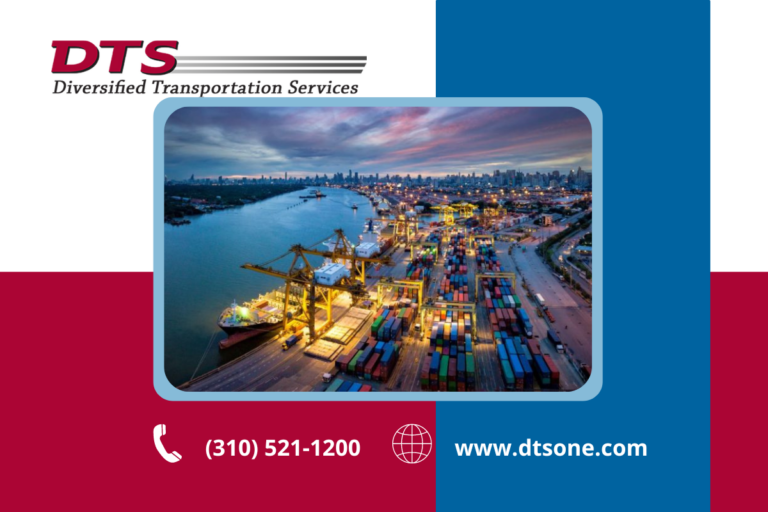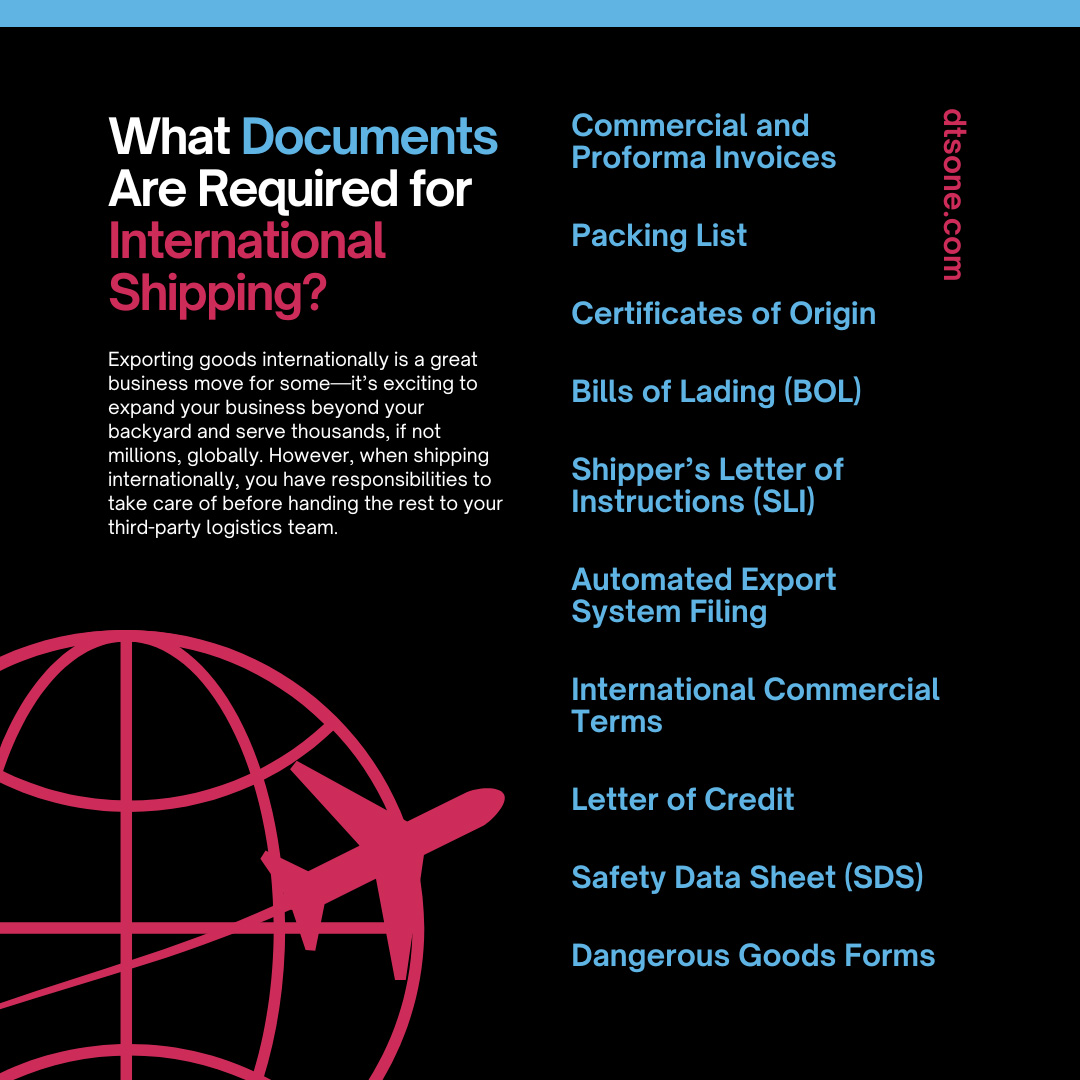
Exporting goods internationally is a great business move for some—it’s exciting to expand your business beyond your backyard and serve thousands, if not millions, globally. However, when shipping internationally, you have responsibilities to take care of before handing the rest to your third-party logistics team.
Here’s everything you need to know about the documents required for international shipping.
Commercial and proforma invoices are preliminary bills of sale sent to the shipper before the shipment or delivery of goods. These invoices help keep shippers accountable for getting the shipment to its destination at its scheduled date and time.
While proforma invoices don’t do much legally in the United States, they are required in South America and Europe. You won’t be able to clear customs without a proforma invoice, but you can use an Automated Export System to deliver the documents quickly.
You need the following information on the invoice:
Before you ship your items, you need a packing list. Not only will this help handlers manage your items properly, but it can also be required for getting through customs officials. Your packing list should identify the items in the shipment, and it would be best if you included the net and gross weight of the package. Ideally, you should have these measurements in both US imperial and metric measurements.
Some countries will require that you provide a certificate of origin. This will identify where the goods originated and include a signature by a semi-official organization like a chamber of commerce. The signature will act as a stamp of approval and prove that your business is legitimate.
However, some chambers will charge you an additional fee to stamp and sign your documents or require you to be a member of the organization.
A bill of lading (BOL) is a form that acts as a receipt for shipping and logistics services. It’s a contract between the shipper and carrier. A bill of lading also highlights the type of transportation and route of the shipment. A BOL will lay out the rules and regulations of who can pick up the cargo.
An inland bill of lading is a contract between the transportation provider and the shipper. It states where the goods are going and is a form of receipt when picking the items up for the drop-off location.
When shipping internationally, the inland bill of lading is consigned to the 3PL managing the movement of your goods internationally or to the warehouse or forwarder that will cosign your items until the products are ready to be shipped.
Goods shipped on a plane will require an airway bill. This is a contract of carriage between the shipper and the carrier. However, it’s important to note that airway bills are NOT negotiable.
When your shipment is shipped by an ocean vessel, you will need an ocean bill of lading. An ocean bill of lading can serve as a document of title for the goods or as a contract of transport.
A straight bill of lading is consigned to a specific consignee and is not negotiable under any terms. The consignee will get their shipment by showing a signed original bill of lading. This means the shipper must deliver the goods to the consignee and no one else.
A negotiable bill of lading is consigned “to order of shipper” and is signed by the shipper and sent to the bank in the client’s or buyer’s country. The bank will hold on to the original bill of lading until the letter of credit has been processed.
Freight forwarders are some of the most important people you will work with throughout this entire international shipment journey. They will help arrange the transport of your goods with a reputable 3PL provider and help ensure that you have everything you need to ship your items.
To help your 3PL provider and freight forwarders, you must provide a shipper’s letter of instructions (SLI). In your SLI, you should give them a few key pieces of information to make their job easier and to get your items shipped safe and sound, including:
If you’re exporting goods valued over 2,500 dollars (per item), you need to use the automated export system filing. This is an online method of filing required export information, and typically the 3PL provider will help with the filing on the seller’s or shipper’s behalf.
To fill out the form, you will need to provide the following:
International commercial terms, or incoterms, are universal guidelines that help flow international trading. These guidelines outline the responsibilities of buyers and sellers, but more specifically, they identify the roles behind the scenes.
Incoterms identify who manages and pays for the shipment, customs clearance, documentation, and insurance. This way, it’s easier to contact the people overseeing each step.
A bank will issue a letter of credit, guaranteeing the shipper’s payment. Letters of credit require specific documentation and preparation before the bank sends them out. Therefore, you must comply with them promptly. Make sure that you present your banker with the following common documents they request:
A safety data sheet is an essential document when shipping goods internationally. This document includes information about handling, storing, and safely disposing of the items inside the shipment. You must follow the International Maritime Organization regulations if your shipment contains hazardous or dangerous materials.
If you’re shipping products considered dangerous goods by the International Air Transport Association (IATA), The United States Department of Transportation, or the International Maritime Organization, you need to include the appropriate dangerous goods form with your shipment.
For the appropriate form, you need to know the classification of your dangerous goods. However, the IATA form is required for air shipments, and there’s a separate form for ocean shipments, so be sure to get the appropriate form.
Note: These forms should be completed by someone trained to handle dangerous goods shipping to prevent mishaps or inaccurate information.
For your average shipper, the terms “dangerous” and “hazardous” are used interchangeably. However, there’s a difference. Hazardous materials are substances or materials the Secretary of Transportation has deemed capable of risking health, safety, and property when transported.
Dangerous goods, on the other hand, are materials or substances capable of posing a risk to safety, health, property, or the environment. So, while hazardous and harmful materials are similar, it’s important that you have proper hazmat training and follow your domestic federal laws, and international shipping laws.
Why rely on something other than professionals to manage your shipping and logistics? At Diversified Transportation Services, we provide professional shipping and logistics services for any business, big or small.
If you have any questions about international or domestic shipping services, don’t hesitate to contact us at 310-521-1200 or visit our contact page.

Whether you're a company looking to improve one facet of your supply chain, your entire supply chain, or simply looking for a transportation and logistics consultation, we can help.